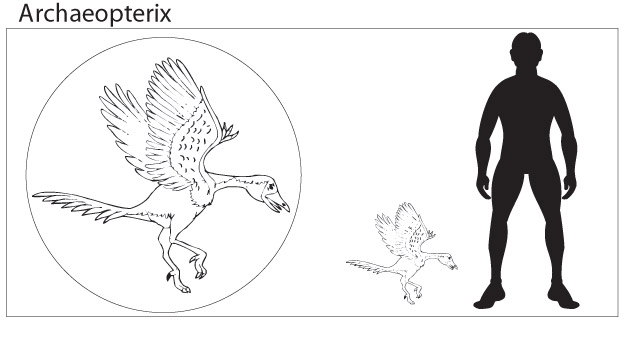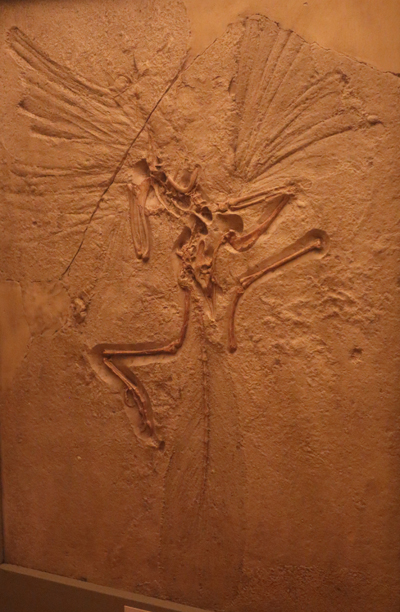American Scientists Seek understanding of Archaeopteryx Anatomy using X-rays
A rare and very precious fossil of an Archaeopteryx is undergoing intensive X-ray scans in the United States in an attempt to discover more about the anatomy of this remarkable missing-link between dinosaurs and birds.
Scientists and researchers from the world famous Stanford University in California are subjecting one of the very few partially articulated fossils of Archaeopteryx to powerful X-rays in an attempt to define internal organs, identify blood vessels and other key aspects of anatomy that may help to unlock the dinosaur/bird evolutionary link.
Archaeopteryx Anatomy
The delicate fossil, one of only a handful of Archaeopteryx fossils ever found; is approximately 150 million years old and, like all the other fossil evidence of this strange toothed bird it comes from the limestone deposits at Solnhofen in Germany.
The Solnhofen deposits consist of extremely finely grained limestone, so fine in fact they were used in the lithographic printing process. These layers of rock outcrop in an east to west direction north of Munich. The various quarries in this area have produced a huge diversity of fossils dating from the Late Jurassic, some 360 different species of animal and plants have been found preserved in the rocks. It seems that 150 million years ago, this part of southern Germany was on the coast and the habitat consisted of a series of shallow lagoons. The very finely grained white mud at the bottom of these lagoons could not support life, perhaps due to the anaerobic conditions, dead animals and plants falling into the still waters, drifted to the bottom and were covered in soft mud. The absence of microbial activity and other organisms to break up the carcases provided ideal conditions for preservation to take place. The lithographic limestone is so finely grained that exquisite details of even the most delicate structures such as feathers can be preserved. The fossil record from this particular part of Germany has permitted scientists to build up a picture of the fauna and flora of the area during this time in the Jurassic. Jellyfish , king crabs, dragonflies, lizards, crocodiles and fish have been preserved as fossils in the limestone. In the air, a number of different types of pterosaur would have been seen, flying over the tropical lagoon, and the crow-sized, primitive bird called Archaeopteryx was also present.
At a specialist laboratory, a large particle accelerator is being used by the Stanford team to bombard the fossil with X-rays that will interact with different elements preserved within the sediment. This will allow the scientists to determine more of the internal structure of this little dino-bird. Although no harm is done to the fossil, the bombardment of light particles should permit the team to identify elements such as calcium (indicating bone) and iron, a key component in haemoglobin which would indicate the location of blood vessels.
Scientists hope the elements identified will correlate with organs, circulatory systems and other interior parts of the creature, perhaps providing more evidence of the evolutionary link between reptiles such as theropod dinosaurs and birds.
Archaeopteryx
Ironically, such sophisticated use of light sources is not always required to shed new light (no pun intended) on Archaeopteryx fossils. The fifth specimen of Archaeopteryx was, for example, classified as a small, lightly built bipedal theropod (Compsognathus), but when this fossil was lit from the side the presence of feathers could be detected indicating that this fossil had been wrongly identified and that it was indeed another specimen of Archaeopteryx.
An Illustration of Archaeopteryx
Picture credit: Everything Dinosaur
“What we are hoping is that we will learn more information than just what you can see with your eyes,” commented Uwe Bergmann, one of the researchers involved with the project.
He went on to state: “the body decays, but the chemical elements — silicon, calcium, potassium, iron, all the chemicals which make up living animals — some of them will be preserved.”
A Replica of an Archaeopteryx Specimen on Display
Picture credit: Everything Dinosaur
In the picture the Archaeopteryx is orientated with the long tail and one limb at the bottom of the picture, the wings are folded back behind the animal and the head and neck have been preserved crushed against the chest.
The application of the powerful X-ray technology is another example in which the science of palaeontology is using new techniques to research the fossil record. Some of the ten or so specimens (one just a single preserved feather), of this ancient bird have been subjected to other sophisticated tests such as CT scans. For example, the famous London specimen was studied by the Natural History Museum a couple of years ago and a more complete analysis of the brain-case revealed hitherto unknown information on Archaeopteryx’s sense of balance and flying ability.
Archaeopteryx Fossils
The Archaeopteryx fossils are perhaps some of the most important fossils found. The Berlin and London specimens have played a pivotal role in the acceptance of Darwin’s theory of evolution. When Charles Darwin first published the Origin of Species in 1859, an argument put forward by his critics was that there was a lack of intermediate animals showing evolution from one species to another in the fossil record. They argued that if animals and plants had been changing through time, then there would be evidence of this process preserved. One of the best and most complete fossil skeletons of Archaeopteryx was found just two years after Darwin’s theory had been formally published. Here was evidence for a “missing link” within the fossil record. A fossil of an animal with both reptilian and avian features.
“If you want to find a single fossil which is a missing link in the evolution of dinosaurs into birds, this is it,” added University of Manchester palaeontologist Phil Manning.
“It’s a bird with sharp teeth, claws and a long bony tail. If you were to freeze-frame evolution, you would end up with Archaeopteryx.”
This particular ancient creature holds a very special place in the science of palaeontology, perhaps the work of the team from Stanford University will be able to shed more light (no pun intended again), on this amazing and fantastic bird.
Everything Dinosaur stocks a range of prehistoric animal models and figures including the Papo model range that includes a replica of Archaeopteryx and other flying creatures: Papo Dinosaur Models.








Leave A Comment